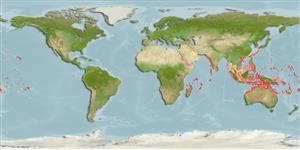Common names from other countries
Environment: milieu / climate zone / depth range / distribution range
Οικολογία
Θαλασσινό(ά) Υφαλόφιλο(α); εύρος βάθους 30 - 50 m (Ref. 1602). Tropical; 32°N - 24°S, 30°E - 145°W
Indo-Pacific: Red Sea to East Africa, through northern Australia to Society Islands, north to southern Japan.
Μέγεθος / Βάρος / Age
Maturity: Lm ? range ? - ? cm
Max length : 55.0 cm TL αρσενικό/απροσδιόριστο; (Ref. 9770)
Ραχιαίες άκανθες (συνολικά) : 3; Μαλακές ραχιαίες ακτίνες (συνολικά) : 24 - 27; Εδρικές άκανθες: 0; Μαλακές εδρικές ακτίνες: 19 - 24. Dark brown, scales with yellow spot; pectoral, soft dorsal, anal and caudal fins dark with yellow margins; juveniles yellowish brown with bluish grey spots and blotches (Ref. 4420). Juveniles under about 5 cm, tan with dark saddles and numerous dark wavy lines on the body. Larger juveniles loose the dark saddles and become covered in a network of brilliant blue lines which become increasingly interconnected with growth (Ref. 37816).
Occur in clear shallow lagoons and seaward reefs; sandy areas near reef patches of reef edge are preferred. Adults on deep reefs or with shipwrecks, usually deeper than 30 meters. Juveniles inshore on rubble reef or small outcrops on open substrate (Ref. 48637). Feed on sea urchins, crustaceans, mollusks, dead fish, tunicates or corals (Ref. 5503). Oviparous (Ref. 205). Monogamous (Ref. 52884). Also caught with drive-in nets. Marketed fresh and dried-salted (Ref. 9770).
Life cycle and mating behavior
Maturities | Αναπαραγωγή | Spawnings | Egg(s) | Fecundities | Προνύμφες
Distinct pairing (Ref. 205). Nest-guarding females are aggressive (Ref. 9770). Females are territorial, solely tending and guarding the eggs. Males exhibit polygyny (Ref. 116451).
Myers, R.F., 1991. Micronesian reef fishes. Second Ed. Coral Graphics, Barrigada, Guam. 298 p. (Ref. 1602)
IUCN Red List Status (Ref. 130435)
CITES (Ref. 128078)
Not Evaluated
Threat to humans
Harmless
Human uses
αλιεία: Εμπορικό(ά); Ενυδρείο: Εμπορικό(ά)
Εργαλεία
Special reports
Download XML
Διαδικτυακές πηγές
Estimates based on models
Preferred temperature (Ref.
115969): 24.7 - 28.4, mean 27.5 (based on 138 cells).
Phylogenetic diversity index (Ref.
82804): PD
50 = 0.6250 [Uniqueness, from 0.5 = low to 2.0 = high].
Bayesian length-weight: a=0.03548 (0.02074 - 0.06071), b=2.94 (2.79 - 3.09), in cm Total Length, based on LWR estimates for this species & (Sub)family-body (Ref.
93245).
Τροφικό Επίπεδο (Ref.
69278): 4.0 ±0.0 se; based on diet studies.
Ελαστικότητα (Ref.
120179): Μεσαίο(α), ελάχιστος χρόνος για διπλασιασμό πληθυσμού 1,4 - 4,4 έτη (Preliminary K or Fecundity.).
Fishing Vulnerability (Ref.
59153): Moderate vulnerability (42 of 100).
